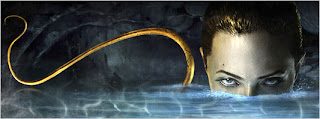Beowulf
 Computers revive Anglo-Saxon literature
Computers revive Anglo-Saxon literatureComputers are playing more than one role in the resurrection of Beowulf. They have largely created the wonderful movie, can be used to download several text and audio copies (for free) from the Gutenberg Project, and have revealed parts of the poem hidden for centuries by digital analysis.
Performance capture
Animation has become truly an
 imate. The performance capture technology takes real performances (Anthony Hopkins takes the rest of the cast to the cleaners with his facial expressions and intonation alone) a complete body scan allows for emotion capture, and everything else can be added, even, in the case of Winston, an entire David-like body and aging 20 years. Grendel is very Gollum-like, and indeed Tolkein was a serious Beowulf scholar. The special effects also allow the Director to do what he wants in terms of fantasy ideas.
imate. The performance capture technology takes real performances (Anthony Hopkins takes the rest of the cast to the cleaners with his facial expressions and intonation alone) a complete body scan allows for emotion capture, and everything else can be added, even, in the case of Winston, an entire David-like body and aging 20 years. Grendel is very Gollum-like, and indeed Tolkein was a serious Beowulf scholar. The special effects also allow the Director to do what he wants in terms of fantasy ideas.The people look like people, not just because the faces are real, and it is just on the edge of mimicking real physics while allowing one to break the laws of both physics and reality. This is an art-form that has come of age, a combination of imagery that has its roots in both film and computer games.
Other-worldly
An obvious point, but keeping the look and feel slightly unreal gives it a coarse and mythic quality. It seems like another age and not quite of this world. The richness of colour and texture counter the slightly wooden movement of the characters and the long tracking shots, and cameras that can move literally on any path in all three directions, give scope for even more hyper-real trickery.
Odd script
The script is rather odd in that it jumps between styles so often. One minute we’re in the Old English (half-English, half-German) then fictional ‘Beowulf-speak’…, the next we’re in modern colloquial “Fancy a gobble?” (a bit of a surprise that line), then back to Homeric-hero talk. Thankfully, it’s a great story of heroes, monsters and dragons but it flagged a little in places, mainly due to script. Overall, however, a triumph. This should be the compulsory introduction to Beowulf for the English GCSE, although it doesn’t stick to the original plot. These stories were written to be told and spoken, not read. The fact that one can create worlds in such glorious detail is a bonus.


0 Comments:
Post a Comment
<< Home